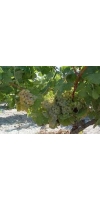Bourboulenc

Bourboulenc (pronounced boor-boo-LAHNK), also known as Aprokondoura, is a white wine variety and comes from Greece, but is now primarily planted in Southern France in the Rhone region. This categorizes Bourboulenc as an ancient wine variety. It is one of only five white wine grapes allowed for use in Chateaneuf du Pape, along with Grenache Blanc, Clairette, Rousanne, and Picardan. It is also used in Provence, Languedoc, La Clape, and Minervois. It displays strong citrus notes, a hint of smoke, some floral attributes, and high acidity. In blends, it will give body and spicy tones. Bourboulenc has a tendency to ripen late, but the acidity retains freshness in the wine. However, it is best consumed young. Bourboulenc grape bunches are tight with large berries and sometimes susceptible to rot. It does well in warmer, sun filled climates with stony plateaus, much like the Mediterranean basin.
No products found
- back
Selected Options
Grape Types
Categories
Pricing
Countries
Regions
Grape Types
Wineries
Organic/Free Shipping
Chavy-Chouet Bourgogne Blanc Femelottes is made form 100 percent Chardonnay.
This is a charming, rich, focused and delightful white. Medium-bodied with a smooth texture, the wine has a fresh backbone of acidity, clean apple and citrus flavors, and an excellent balance. A most refreshing quaff and one that is great value. A delicate, expressive wine of exceptional quality.
The grapes from this wine are grown from the Puligny-Montrachet area. (either outside of the AOC limit or with younger vines).
The grapes from this wine are grown from the Puligny-Montrachet area. (either outside of the AOC limit or with younger vines).
Aged 10 months in oak barrels (10% new, the rest in 2-3 year old barrels).
Intense, fresh and fruity bouquet, reminiscent of a tangy red fruit tart (wild strawberry, blueberry), slightly sweet yet underpinned by more concentrated, jammy and citrus notes. The aromatic complexity comes through after a few swirls in the glass giving us a medley of spice, warm cinnamon and peppers. Fleshy attack dominated by ripe, crunchy, plump red fruit that brings depth and creaminess. The fruity structure is gradually elongated by a chalky, mineral freshness that creates a lingering sensation of lightness and harmony on the finish.
Review:
Roederer's 2014 Brut Vintage is beautiful, offering up aromas of pear, mirabelle plum, red berries, warm biscuits and smoke. Full-bodied, layered and elegantly muscular, it's seamless and complete, with terrific mid-palate depth and amplitude. Framed by bright acids and enlivened by a pinpoint mousse, it concludes with a penetrating finish. The blend is 70% Pinot Noir, emphasizing Verzy, and pressure is a touch higher than in its more ethereal Blanc de Blancs counterpart. As I wrote of its 2013 predecessor, this is a wine that puts many prestige cuvées to shame.
95 Points Robert Parker's Wine Advocate




